The Early Bird Gets the Worm
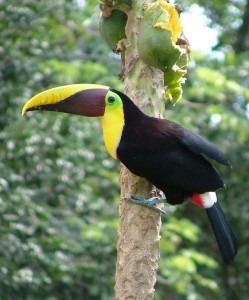
By Jack Ewing
Be Careful Bird Watching is Addictive
Do you think birds are boring, and don’t see why anyone would want to watch them? Don’t put this article down yet. Let me share with you one interesting tidbit of information about birds, and see if you still think they are boring.
Many member of the cuckoo family are freeloaders. Ornithologists call them brood parasites. They lay their eggs in other birds nests, dumping their responsibility as parents in other birds laps, while saving themselves the time and energy of incubating eggs and feeding chicks. The various bird species that end up as unsuspecting foster parents have devised certain tricks with which they try to outsmart their unwelcome boarders. A truly fascinating method came to light recently in Australia where researchers were studying the behavior of the superb fairy-wren (Malurus cyaneus). Mother wrens sing to their eggs, and, in so doing, teach their embryonic offspring a password, even before they hatch. After hatching, the chicks don’t get fed unless they include the password in their begging call. The cuckoo chicks that hatch in the same nest don’t know the password, don’t get fed, and end up starving to death. The female wrens conserve their own energy and devote it to raising their own young. Every mother wren uses a different password, presumably to prevent the cuckoo chicks as a species from learning how to get fed. You can read the entire article at: http://www.nature.com/news/wrens-teach-their-eggs-to-sing-1.11779#b2.
It occurred to me that it would be a lot simpler if the wrens could just evolve the ability to recognize the cuckoo eggs, which are considerably larger than wren eggs, and throw them out of the nest in the first place. I am sure Mother Nature has a good reason. Maybe someday we will know what it is.
Counting Birds
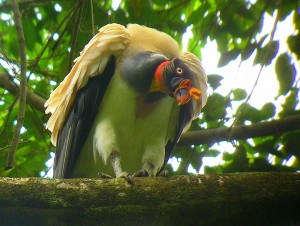
As this issue of Quepolandia comes off the press, a group of about 40 ornithologists and highly qualified birders will be counting birds in the official 2012 bird count in the Path of the Tapir Biological Corridor. You may ask why anyone would want to count birds, or even watch them, for that matter? I mean, what’s the big deal? Why do people get all worked up over chasing after birds while lugging along spotting scopes, tripods, binoculars and bird books. Why don’t people watch frogs, for example, or bats, monkeys or fish? Why is bird watching so special all over the world, and especially in Costa Rica?
In addition to a multitude of interesting aspects of bird behavior, such as the example cited above, I believe the answer lies in the great diversity of birds, not only in terms of number of species — around 9800 worldwide — but also diversity of habitat, being found in places as different as the polar caps, tropical rainforests, deserts, far out to sea, and even the very center of large cities. Their diversity in appearance is equally extreme, some being colorful, others drab, and some so well camouflaged as to be nearly invisible. Many birds have a melodious song, some are downright obnoxious, and others mute. Some soar high above the ground floating listlessly on thermal currents, some fly like stunt planes, others streak through the sky like fighter jets, and some are flightless. Their sizes range from that of the tiniest humming bird, only slightly larger than a bumble bee and weighing no more than a couple of paper clips (1.95 grams,) to the enormous Andean Condor with a wing span of 3.4 meters (11 feet) and a weight of over 14 kilos (30 pounds.) Even larger is the Ostrich which can reach a height of 2.7 meters (9 feet,) a weight of 155 kilos (340 pounds,) and, though flightless, can run at speeds of up to 70 kph, (43 mph.) Birds, in all their extremes, are fascinating, and for that reason bird watching attracts more enthusiasts every year.
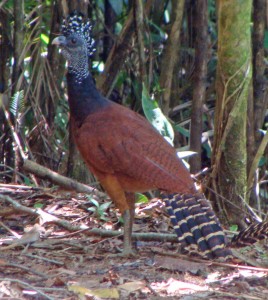
Another reason that people love to observe, identify, list and count birds is that for over a century the American Audubon Society has diligently gathered, organized and disseminated information about them. One of the best known activities of the society is the Christmas Bird Count (CBC.) This tradition actually began as a bird hunt with competition between different groups of hunters to see who could kill the most birds on Christmas day. In the year 1900, the activity was taken over by the Audubon Society and converted into a bird census, with different teams counting in different areas. The purpose of the CBC, as it is practiced today, is to gather information about bird species in many locations throughout the Americas. It is probably the most effective tool for bird monitoring that has ever been devised.
Our local bird count in the area around Hacienda Baru is called the Path of the Tapir annual bird count. It takes place in an area that extends from the mouth of the Hatillo Viejo River, south to the mouth of the Morete River in Uvita, and from the coast about 15 kilometers (9.3 miles) inland to the other side of the Tinamastes Ridge. The altitude ranges from sea level to 1300 meters (4225 feet.) The habitats represented include sea shore, river mouth, river bank, mangrove estuary, wetland, pasture, farm land, secondary forest, primary forest and swamp forest. This diversity in terrain adds up to a lot of different birds, both in species and individuals. The count for the entire area, in any given year, usually falls between 350 and 395 species. The largest count was in 2009 with 393 species identified. In the nine years since the first Path of the Tapir CBC, on January 3, 2003, a total of 488 species of birds have been identified within the entire count area.
In addition to being a great stimulus to bird watching in Costa Rica and this region, the Christmas Bird Count is an effective and accurate method of gathering and compiling useful and interesting information about our feathered friends. And, all of us birders are pleased to know that, in spite of a great deal of damage to some natural areas, the result of uncontrolled development in past years, there are still plenty of birds to watch in the Path of the Tapir.
Early Birds and Early Birders
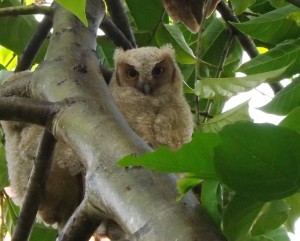
Back when I was a kid, more years ago than I care to remember, our family lived near a park with a big, beautiful lawn. I remember seeing red-breasted robins plucking worms out of that lawn, and always imagined that that old saying about the early bird getting the worm was written about those robins. The truth of the matter is that I wasn’t an early riser in those days, and have no way of knowing if robins got more worms in the early morning or not, but they got plenty of them during the rest of the day. In my ripe old age I have become an early riser. In Costa Rica, I have never seen a bird eat a worm at any time of day, but I can assure you that they do start their days early, and early birders definitely see more birds.
This morning, shortly after daybreak, I went outside with my binoculars and scanned the area near the house. During a leisurely ten-minute walk around the yard I identified nine species of birds, the most exciting of which was a Tropical Screech Owl asleep in a tree. Owls, of course, aren’t “early birds,” rather they are “night owls,” and sleep all day. There was also a flock of orange-chinned parakeets noisily waking up, several species of flycatchers and doves, a woodpecker, and a palm tanager. A half hour later, with the sun peeking over the tall trees, I went out for another ten minutes, and added four more species to my list for the day. These early morning hours almost always yield the most diversity of bird life. I had searched for a total of around twenty minutes, in an area limited to our yard, and had come up with 13 different species. I tried it again at noon, and got only three species in twenty minutes, one of which was a black vulture circling overhead. After 3:30 in the afternoon bird activity tends to pick up again, and I usually see five or six species on a ten-minute walk from my house to the office. All of this is during the good birding season.
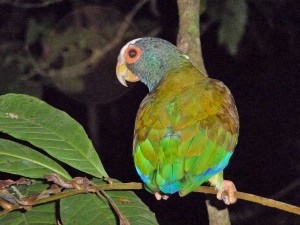
The best birding season is right now. November through March, the time when the northern migrants are here, around 200 of them. In all of Costa Rica, not counting Cocos Island, there are about 600 year around resident species. The Asociación Ornithológico de Costa Rica officially lists 857 species, including the migrants, on the mainland and 19 species on Cocos Island. Another 17 species have been identified here at one time or another, but were considered to be here by accident, and can’t be counted as true species of Costa Rica. These might include birds that people had in captivity and later released into the wild, or perhaps a bird that blew in with a storm. It is also interesting to note that this total of 893 species for tiny Costa Rica is more than the total number of species identified in all of the mainland United States and Canada combined.
One morning last August, I was going about my morning chores when I heard a strange sound, krwa-krwa-krwa-krwa, coming for outside the house, so strange that our dogs ran outside barking. I grabbed my binoculars and followed. In the leafless top of a cecropia tree perched a bird I had never seen before. It was a dark, metalic green, had a long curved bill and a body that resembled that of a common water bird called the white ibis. After retreiving my bird book I quickly determined that I was looking at the green ibis (Plegadis chihi,) a bird found on the Caribbean side of the country, and not very common even there. It was very strange indeed to find it here on the Pacific coast. My luck held and it stayed put long enough for me to get a couple of photos. It was a new bird for my lifetime list and a new bird for Hacienda Barú.
All birders make lists, daily lists, yearly lists, trip lists, and lifetime lists. At Hacienda Barú we have been identifying bird species for the last 26 years, and in that time have made definite identifications of 363 species. That is our lifetime list, and we still add one or two new species to it each year. So far in 2012, we have positive sightings on the green ibis, already mentioned, and the shiny cow bird, another species usually seen only on the Caribbean.
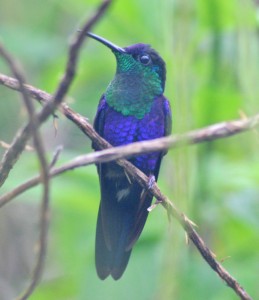
Bird watchers who come to Costa Rica for the first time add many new species to their lifetime lists. Bird Watchers come from all over the world. One of my first experiences as a guide was with some birders from England. I was the guide, but they taught me a great deal more than I taught them. The British are very serious about their birding and are really good at it. In addition we have hosted birders from the United States, Canada, France, Germany, Belgium, Spain, Italy, South Africa, Japan, and China. When the couple from South Africa made their reservation the lady asked if there was a chance of seeing a hummingbird during their stay. I told her she could stay for free if she didn’t see at least one hummingbird every day while she was here. She wasn’t disappointed. We have 18 different species of hummingbirds at the Baru National Wildlife Refuge.
Are you ready to try it? All you need is a pair of binoculars and a bird book. Just start looking at birds and identifying them. Each new bird goes on your lifetime list. The more you learn about them the more enthralled you will be. Let me warn you though, bird watching is addictive.

